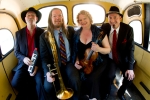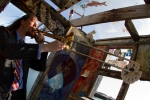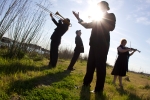I had the pleasure of spending a full day photographing the brilliantly talented and passionate members of Tango No.9 near the Oakland Marina. A few images from our shoot grace the pages of their newly designed website, while others remain tucked in their back-pocket, to be released when you least expect. If you’ve never heard their music, you can listen to their haunting melodies on “Live At The Columbarium” here. It will either make you break into dance, or wish you could.
Jay Shefsky for the Chicago Tonight show at WTTW in Chicago tells the story of Vivian Maier http://www.wttw.com/chicagotonight
This video is a great reason to share your gifts with the world while you’re alive. Don’t just create and store the work in boxes for others to sort through. Let it exist- let yourself exist along with it. Incredible work- and a mystery.
To get familiar with FCPX, I’m working on a series of short videos. I love shooting anything related to music- it helps to have friends who are fantastic subjects, willing to allow my camera in their faces regularly (Thank you Zoli & Tango No.9). This was shot with the 5D MarkII– very low light. I believe I was at 2500ISO, which makes the footage a bit grainy. My exposure: 100 @ f2.8 with Canon’s 24-70 2.8L lens, and I had a shotgun mic attached.
The Red Poppy Art House on 23rd and Folsom St. (Mission) is an intimate space to begin with- but it was so packed on Friday, people were sitting on the floor and standing clear to the doorway. I had reserved a chair on the end of the first row and I was literally stuck there until the intermission. As far a “stuck” goes, this was an amazing location to be stuck, don’t get me wrong. Front row, up close & personal with Greg Stephens’ trombone…
but from a video standpoint- on first glance it did have its limitations. This was not a situation where walking in front of people is an option- and I was fairly sure when the show began, I wasn’t going to be able to capture it from my lack-of-vantage point. However, the longer I sat there, the more I noticed details- shadows and reflections at play. The advantage of sitting in one place- you sit there long enough, and eventually- the magic reveals itself. From my position, I couldn’t clearly see Joshua at the piano due to a music stand, but I started to notice the light refracting through his glasses onto the sheet music.
Although I couldn’t directly see Catherine, I could see her shadow articulated on the red velvet curtain as she played the violin (which I found visually decadent). At the intermission, I walked behind the piano and discovered underneath the mailing list & CD’s for sale, it had a glossy, reflective surface which I’m a bit of a sucker for, I’ll admit. That’s where I stayed for the duration. Combining the two perspectives (wide vs. detail) hopefully creates the illusion of moving around the room.
Final Cut Pro X (FCPX): As I explore this editing program- one of my favorite features so far, is the way you can highlight a section of a clip and keyword it or mark it as a favorite. This is SO efficient compared to my former logging workflow in FCP7. Although I’m still figuring out the best workflow for layering tracks, this basic edit took about 3 hours to edit from import to export.
One confusing element of FCPX- is that the project doesn’t automatically open in the timeline when you close/re-start the program as it did in FCP7. Not only that, but it’s not clear to me, just yet, where the files are going. I shut down my computer prior to exporting and temporarily couldn’t locate my edit when I re-opened the program. Google steered me to a forum that suggested, when you have an external HD attached and event folders on both system and external drive, FCPX may not recognize the project at all. I had duplicate folders on both system drive and external for back-up. Although it seems a bit ridiculous, this did turn out to be my problem. I had to trash the event folders from my main HD, after which my edited project was visible in the viewer (not timeline). Will be looking more into this issue… TBA. I realize what are current annoyances with workflow will soon become second nature. The process of discovery is always interesting if nothing else, right? Here’s the final product…
Wondering what the future holds for documentary photographers? Visual Journalists are defining and re-defining their future and the way their living is made on a daily basis. Photoshelter hosted a conversation to dig into this topic. As per the Photoshelter description: “The panel included photojournalist James Estrin of the New York Times LENS Blog, TIME Magazine Deputy Photo Editor Paul Moakley, director of CLAMPART Brian Paul Clamp, and Bess Greenberg of 25CPW.”
You can join the conversation on Photoshelter’s Blog.
I’ve had the honor of photographing students, families and some of the key leaders for public school reform for the National Equity Project (formerly BayCES) this year. The portraits will be part of a permanent exhibit in their newly remodeled office in downtown Oakland, installed November 2010.
8 million views in a day is mind-blowing… I’ve been reading a lot about attention spans this week related to multimedia and online publishing, and came across this web story in relation to the debate about long-form journalism on the web vs. sampling. Some say we’ve become a “sampling-culture”- and I’ve noticed this to be increasingly true in myself. When I want to learn more about something, I might have 10 different tabs open comparing what the “word” is on a particular subject. With that said, I came across this article published by the Nieman Journalism Lab- exploring the Boston Globe’s online story about the death of Ted Kennedy (’09), which brilliantly has sampling built in to the web story interface. I challenge you to check out this story and NOT get entirely sucked in. It’s beautifully crafted and come’on- this is an endlessly fascinating family! The story is essentially a website in itself- with links to newspaper articles, super8 home-movies, letters… more personal information than I personally feel like I have any right to see… (yet I’m looking)! The Globe found that making videos prominent became a gateway for viewers to become engaged and want to know more. There’s been some debate about whether people will read long-form journalism on the web, and in this case it appears that viewers who become engaged through video often want to know more and will go on to read a long-form articles as well. Regardless- it’s always inspiring to see great storytelling on the web and this is truly an example. Bravo, Boston Globe.
I showed this piece to my class last semester and it took everyone’s breath away. I’m posting this today because it’s the single most requested link in my life! I mean, seriously- Will Hoffman… this is incredible! Touching- human moments you can’t help but relate to. The music loop is gentle- doesn’t force any particular emotion on you (thank you!) but moves the piece along. This is a brilliant example of how to cut video- on motion, form, color… inspiring.
I’m taking the summer off to write a Multimedia Course for the Academy of Art University in SF. I’m writing about editing theory this week, which starts and ends with stop-motion. In the beginning was Edweard Muybridge’s discovery of stop-motion… over 100 years later was Ed Kashi’s discovery of digital stop-motion- discovered when rapidly scrolling through 17,000 images(!) for the Iraqi Kurdistan story (National Geographic).
During my research, I came across this piece: two guys walking the longest street in Ontario, taking one photo every 30 seconds. This is a fun piece- lots of energy to create (notice the changing light…) very clever!
Click here to view the opening reception gallery.
I was not prepared for the emotion I felt walking into Darcy Padilla’s exhibit, “The Julie Project.” I’ve seen bits and pieces of this project over the past three years, but none of those pieces prepared me to walk in and stand in the visual span of seventeen years of Julie’s life. All of the images are black and white- the moments captured, incredibly intimate, humbling.
Reading the quotes and conversations, I realize these people would have lost each other long ago- Darcy has held the pieces of this story across their moves, illness, prison, birth, death… I realize this type of story plays out constantly in the world for many, many families. The pieces slip away or no one cares to remember the details. We see the summation of cause and effect in a homeless face on the street every day. It can be too complicated, uncomfortable and painful to ask why. Darcy asks why for us- Julie’s is the rare story that lives to be told.
Andy Patrick, founder of Fifty Crows, mentioned in his opening talk: these images can be hard to look at. The words that stuck with me were something like: “I hope you can’t stop thinking about these images- I hope they make you cry.” I thought about those words as I walked out of the exhibit, because I saw many people cry in the exhibit- and I, myself, was teary almost immediately. Why does that matter? When you feel something you look at the world differently. This exhibit is an invitation to feel something. Where that takes you- is up to you.












 Marantz PMD 660 User's Manual .PDF
Marantz PMD 660 User's Manual .PDF